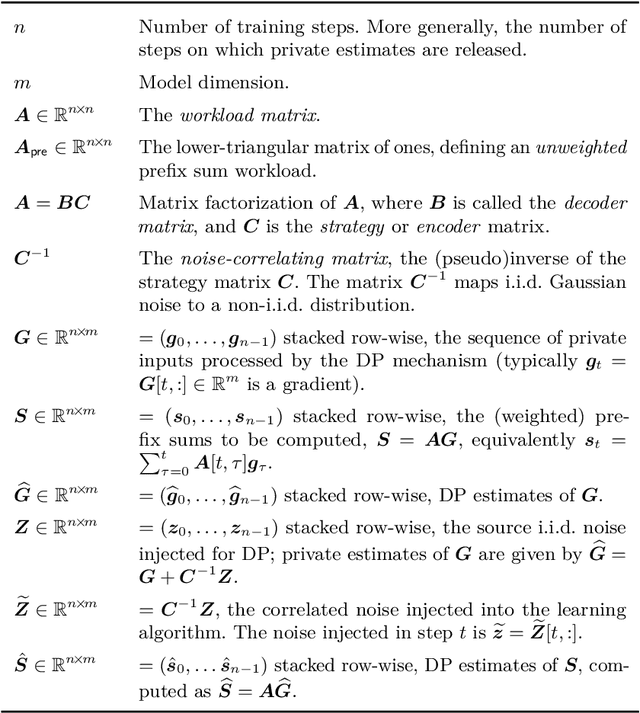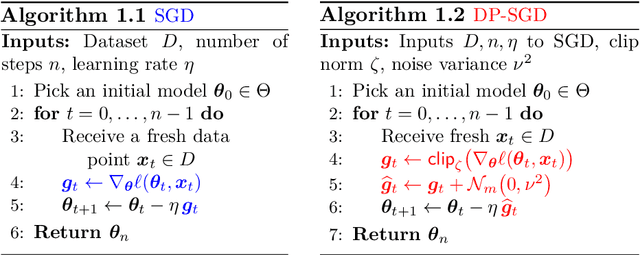H. Brendan McMahan
Correlated Noise Mechanisms for Differentially Private Learning
Jun 09, 2025



Abstract:This monograph explores the design and analysis of correlated noise mechanisms for differential privacy (DP), focusing on their application to private training of AI and machine learning models via the core primitive of estimation of weighted prefix sums. While typical DP mechanisms inject independent noise into each step of a stochastic gradient (SGD) learning algorithm in order to protect the privacy of the training data, a growing body of recent research demonstrates that introducing (anti-)correlations in the noise can significantly improve privacy-utility trade-offs by carefully canceling out some of the noise added on earlier steps in subsequent steps. Such correlated noise mechanisms, known variously as matrix mechanisms, factorization mechanisms, and DP-Follow-the-Regularized-Leader (DP-FTRL) when applied to learning algorithms, have also been influential in practice, with industrial deployment at a global scale.
An Inversion Theorem for Buffered Linear Toeplitz (BLT) Matrices and Applications to Streaming Differential Privacy
Apr 30, 2025Abstract:Buffered Linear Toeplitz (BLT) matrices are a family of parameterized lower-triangular matrices that play an important role in streaming differential privacy with correlated noise. Our main result is a BLT inversion theorem: the inverse of a BLT matrix is itself a BLT matrix with different parameters. We also present an efficient and differentiable $O(d^3)$ algorithm to compute the parameters of the inverse BLT matrix, where $d$ is the degree of the original BLT (typically $d < 10$). Our characterization enables direct optimization of BLT parameters for privacy mechanisms through automatic differentiation.
Federated Learning in Practice: Reflections and Projections
Oct 11, 2024Abstract:Federated Learning (FL) is a machine learning technique that enables multiple entities to collaboratively learn a shared model without exchanging their local data. Over the past decade, FL systems have achieved substantial progress, scaling to millions of devices across various learning domains while offering meaningful differential privacy (DP) guarantees. Production systems from organizations like Google, Apple, and Meta demonstrate the real-world applicability of FL. However, key challenges remain, including verifying server-side DP guarantees and coordinating training across heterogeneous devices, limiting broader adoption. Additionally, emerging trends such as large (multi-modal) models and blurred lines between training, inference, and personalization challenge traditional FL frameworks. In response, we propose a redefined FL framework that prioritizes privacy principles rather than rigid definitions. We also chart a path forward by leveraging trusted execution environments and open-source ecosystems to address these challenges and facilitate future advancements in FL.
A Hassle-free Algorithm for Private Learning in Practice: Don't Use Tree Aggregation, Use BLTs
Aug 16, 2024



Abstract:The state-of-the-art for training on-device language models for mobile keyboard applications combines federated learning (FL) with differential privacy (DP) via the DP-Follow-the-Regularized-Leader (DP-FTRL) algorithm. Two variants of DP-FTRL are used in practice, tree aggregation and matrix factorization. However, tree aggregation suffers from significantly suboptimal privacy/utility tradeoffs, while matrix mechanisms require expensive optimization parameterized by hard-to-estimate-in-advance constants, and high runtime memory costs.This paper extends the recently introduced Buffered Linear Toeplitz (BLT) mechanism to multi-participation scenarios. Our BLT-DP-FTRL maintains the ease-of-use advantages of tree aggregation, while essentially matching matrix factorization in terms of utility and privacy. We evaluate BLT-DP-FTRL on the StackOverflow dataset, serving as a re-producible simulation benchmark, and across four on-device language model tasks in a production FL system. Our empirical results highlight the advantages of the BLT mechanism and elevate the practicality and effectiveness of DP in real-world scenarios.
Fine-Tuning Large Language Models with User-Level Differential Privacy
Jul 10, 2024Abstract:We investigate practical and scalable algorithms for training large language models (LLMs) with user-level differential privacy (DP) in order to provably safeguard all the examples contributed by each user. We study two variants of DP-SGD with: (1) example-level sampling (ELS) and per-example gradient clipping, and (2) user-level sampling (ULS) and per-user gradient clipping. We derive a novel user-level DP accountant that allows us to compute provably tight privacy guarantees for ELS. Using this, we show that while ELS can outperform ULS in specific settings, ULS generally yields better results when each user has a diverse collection of examples. We validate our findings through experiments in synthetic mean estimation and LLM fine-tuning tasks under fixed compute budgets. We find that ULS is significantly better in settings where either (1) strong privacy guarantees are required, or (2) the compute budget is large. Notably, our focus on LLM-compatible training algorithms allows us to scale to models with hundreds of millions of parameters and datasets with hundreds of thousands of users.
Efficient and Near-Optimal Noise Generation for Streaming Differential Privacy
Apr 26, 2024Abstract:In the task of differentially private (DP) continual counting, we receive a stream of increments and our goal is to output an approximate running total of these increments, without revealing too much about any specific increment. Despite its simplicity, differentially private continual counting has attracted significant attention both in theory and in practice. Existing algorithms for differentially private continual counting are either inefficient in terms of their space usage or add an excessive amount of noise, inducing suboptimal utility. The most practical DP continual counting algorithms add carefully correlated Gaussian noise to the values. The task of choosing the covariance for this noise can be expressed in terms of factoring the lower-triangular matrix of ones (which computes prefix sums). We present two approaches from this class (for different parameter regimes) that achieve near-optimal utility for DP continual counting and only require logarithmic or polylogarithmic space (and time). Our first approach is based on a space-efficient streaming matrix multiplication algorithm for a class of Toeplitz matrices. We show that to instantiate this algorithm for DP continual counting, it is sufficient to find a low-degree rational function that approximates the square root on a circle in the complex plane. We then apply and extend tools from approximation theory to achieve this. We also derive efficient closed-forms for the objective function for arbitrarily many steps, and show direct numerical optimization yields a highly practical solution to the problem. Our second approach combines our first approach with a recursive construction similar to the binary tree mechanism.
(Amplified) Banded Matrix Factorization: A unified approach to private training
Jun 13, 2023



Abstract:Matrix factorization (MF) mechanisms for differential privacy (DP) have substantially improved the state-of-the-art in privacy-utility-computation tradeoffs for ML applications in a variety of scenarios, but in both the centralized and federated settings there remain instances where either MF cannot be easily applied, or other algorithms provide better tradeoffs (typically, as $\epsilon$ becomes small). In this work, we show how MF can subsume prior state-of-the-art algorithms in both federated and centralized training settings, across all privacy budgets. The key technique throughout is the construction of MF mechanisms with banded matrices. For cross-device federated learning (FL), this enables multiple-participations with a relaxed device participation schema compatible with practical FL infrastructure (as demonstrated by a production deployment). In the centralized setting, we prove that banded matrices enjoy the same privacy amplification results as for the ubiquitous DP-SGD algorithm, but can provide strictly better performance in most scenarios -- this lets us always at least match DP-SGD, and often outperform it even at $\epsilon\ll2$. Finally, $\hat{b}$-banded matrices substantially reduce the memory and time complexity of per-step noise generation from $\mathcal{O}(n)$, $n$ the total number of iterations, to a constant $\mathcal{O}(\hat{b})$, compared to general MF mechanisms.
Unleashing the Power of Randomization in Auditing Differentially Private ML
May 29, 2023Abstract:We present a rigorous methodology for auditing differentially private machine learning algorithms by adding multiple carefully designed examples called canaries. We take a first principles approach based on three key components. First, we introduce Lifted Differential Privacy (LiDP) that expands the definition of differential privacy to handle randomized datasets. This gives us the freedom to design randomized canaries. Second, we audit LiDP by trying to distinguish between the model trained with $K$ canaries versus $K - 1$ canaries in the dataset, leaving one canary out. By drawing the canaries i.i.d., LiDP can leverage the symmetry in the design and reuse each privately trained model to run multiple statistical tests, one for each canary. Third, we introduce novel confidence intervals that take advantage of the multiple test statistics by adapting to the empirical higher-order correlations. Together, this new recipe demonstrates significant improvements in sample complexity, both theoretically and empirically, using synthetic and real data. Further, recent advances in designing stronger canaries can be readily incorporated into the new framework.
Federated Learning of Gboard Language Models with Differential Privacy
May 29, 2023



Abstract:We train language models (LMs) with federated learning (FL) and differential privacy (DP) in the Google Keyboard (Gboard). We apply the DP-Follow-the-Regularized-Leader (DP-FTRL)~\citep{kairouz21b} algorithm to achieve meaningfully formal DP guarantees without requiring uniform sampling of client devices. To provide favorable privacy-utility trade-offs, we introduce a new client participation criterion and discuss the implication of its configuration in large scale systems. We show how quantile-based clip estimation~\citep{andrew2019differentially} can be combined with DP-FTRL to adaptively choose the clip norm during training or reduce the hyperparameter tuning in preparation for training. With the help of pretraining on public data, we train and deploy more than twenty Gboard LMs that achieve high utility and $\rho-$zCDP privacy guarantees with $\rho \in (0.2, 2)$, with two models additionally trained with secure aggregation~\citep{bonawitz2017practical}. We are happy to announce that all the next word prediction neural network LMs in Gboard now have DP guarantees, and all future launches of Gboard neural network LMs will require DP guarantees. We summarize our experience and provide concrete suggestions on DP training for practitioners.
Can Public Large Language Models Help Private Cross-device Federated Learning?
May 20, 2023



Abstract:We study (differentially) private federated learning (FL) of language models. The language models in cross-device FL are relatively small, which can be trained with meaningful formal user-level differential privacy (DP) guarantees when massive parallelism in training is enabled by the participation of a moderate size of users. Recently, public data has been used to improve privacy-utility trade-offs for both large and small language models. In this work, we provide a systematic study of using large-scale public data and LLMs to help differentially private training of on-device FL models, and further improve the privacy-utility tradeoff by techniques of distillation. Moreover, we propose a novel distribution matching algorithm with theoretical grounding to sample public data close to private data distribution, which significantly improves the sample efficiency of (pre-)training on public data. The proposed method is efficient and effective for training private model by taking advantage of public data, especially for customized on-device architectures that do not have ready-to-use pre-trained models.
 Add to Chrome
Add to Chrome Add to Firefox
Add to Firefox Add to Edge
Add to Edge